 |
Bulletin
- 17 December 2001 |
Passage from Vanuatu to
Thursday Island, Australia |
|
|
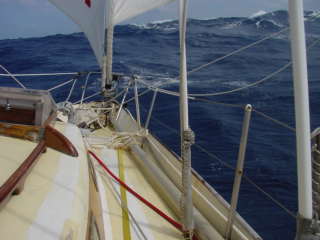
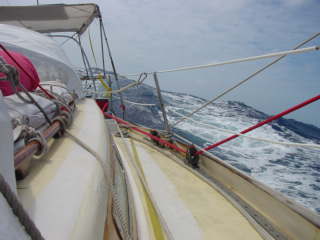
|
We set off from Vanuatu on an overcast and dull day, (August 6th )just after an early lunch, to catch the tide out between the islands. Just after we dropped our mooring, it started to rain steadily, and as we made our way down through the tide race the wind started to blow from the south – straight on the nose. It then blew at about 25 – 30 knots (not forecast) from the south for about 36 hours, giving us a rough reach for the first 36 hours of the passage,
though at least it stopped raining during our first night.
|
However, the wind eased a little and the sea followed and for the next week or so we had delightful sailing conditions – perfect for Helen’s birthday which was celebrated with a delicious Fortnum and Mason cassoulet, prepared and served by John. This was drawn out of a mystery bag of wrapped goodies given to us at the start of the journey by John’s son and daughter-in-law, Jeremy and Clare, and which is kept for special occasions. We have declared an embargo on presents between us, as so much of this trip is one long present! The other highlights of the birthday were via radio: Barry and Annette of Just Magic singing Happy Birthday over the radio, and receiving a happy birthday message from my father on the daily radio schedule. Earlier when we were at sea, we had asked friends on Ironbark with on-board radio-email to send him a birthday message, and he used their address to send his greetings, which they in turn relayed to Des, who runs a reporting-in and weather-advice radio sched from New Zealand. He in turn relayed it to us!
|
|
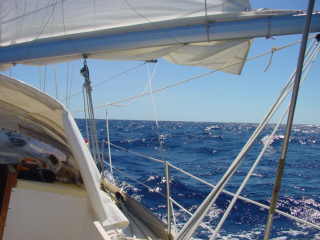
|
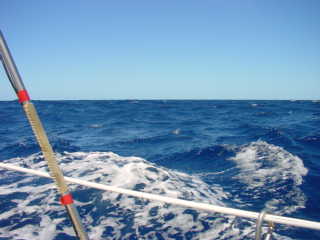
|

|
This was a really delightful part of the passage – the nights were dark and starry, with a new moon only just beginning to wax. The Milky Way was fantastic, with a few particularly white spots, whose individual star could only be seen through binoculars.
On August 22nd we celebrated the half way stage of what we had calculated would be our third longest passage overall – 1600 odd miles. There was a spectacular sunset, against a bright, clear blue sky. The sun took two minutes to set, from the moment its lower edge touched the (now flat) horizon. It was followed by a spectacularly starry night, in which Cassiopaea appeared for the first time in months, and during which we were very aware of the movement of the universe “around us” from east to west.
The following night, by contrast, was a dark, overcast night, with neither clouds nor stars visible. The only light came from the dimly visible twin headsails pulling us along and from the phosphorescent foam racing out from our bow wave. The following morning we counted 30 flying fish scattered around the deck – there are always many more on moonless nights!
|
|
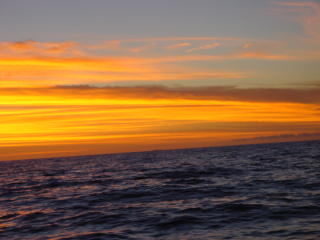
|
And the next evening, another beautiful, gentle, rosy sunset, in an overcast sky so that we couldn’t see the sun itself, just a vast warm orange glow which was reflected into the boat down below.
|
The route round Cape York, the northern eastern most tip of Australia, takes one a long way off the Australian coast, to avoid the outer northern end of the Great Barrier Reef. During these last few nights we were therefore approaching and sailing parallel to, though well offshore, the south coast of Papua New Guinea, and had decided to sail with lights off, so as not to attract any opportunist trouble makers.
On the night of 25th/26th August we passed Eastern Fields, the outermost reef, which is about 90 miles west south west of Port Moresby, but 120 miles north east of Cape York. So one is closer to PNG than to Australia, and we never did discover where Australian waters began, despite asking Thursday Island Customs, when we reported our approach by radio – phone link!
Finally, at midnight, just before Bramble Cay, the main entrance into the Torres Strait, we turned inside the Barrier Reef, hardened up the sails and headed roughly south west. (The Torres Strait is anything but straight!) Fishing boats started to appear (we hadn’t seen a single other boat or ship since leaving Vanuatu!), seemingly in their hundreds, though they all seemed to keep clear of the Great North Eastern Channel, which we had entirely to ourselves. We had expected to see at least a few ships, and to have to avoid them, in this main shipping channel, but there was nothing, till later in the morning. This area is notorious for its accelerated trade winds and rough seas, but early in the morning the wind died completely and we had to motor. Later, a gentle wind did appear, but we decided to keep motoring, so as to be able to drop anchor that night.
A small plane flew over us as we motor sailed along, and, though we had been warned by other yachtsmen, it was only as it came over the third time that we realised it must be the Customs CoastWatch service. They checked by radio on our details and flew off. We were taken aback though to be buzzed again only a few hours later.
|
|
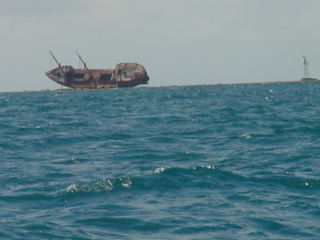
|
We passed a graphic illustration of the need for careful navigation here, when we saw this shipwreck on one of the reefs to the north of the aptly named Vigilant Channel.
Seeing such a wreck always sends a shiver through a navigator’s spine!
|
After that, it was with particular care, even though in such calm conditions, that we threaded our way through the islands away from the main shipping route, into the recommended anchorage off Horn Island, just to the south of Thursday Island, or TI as we quickly came to know it.
Once we were anchored, at 2320, it was completely still, like a millpond. It was so quiet that night, that we kept waking up!
|
TI |
|
In the morning, TI and its surrounding islands appeared as unexpectedly small rounded green hummocks – we had expected a harsher landscape somehow. The customs and quarantine service came aboard, were very friendly, and allowed us to bond most of our stores, rather than confiscating them. (The rules for bringing foodstuffs into Australia are draconian, not concentrating only on fresh foods, as in Vanuatu, and we still had quite a lot of tinned stores on board.) They even brought a map of the town, told us where to find the laundry, internet café, etc and recommended an excellent restaurant, where we celebrated having crossed the Pacific!
The islands between here and PNG are inhabited by aboriginal people known as the Torres Strait Islanders, who are of Melanesian origin. The Customs service has the difficult task of distinguishing between the Islanders, who are Australian, and people from PNG (whose islands are in several cases only a couple of miles from Australia’s), who would like to be Australian. We arrived just as pre-election Australia was in the throes of a heated political rumpus about illegal immigrants, so it was a topical subject!
We have become so used to trying to understand a new culture that we had to remember there was (largely!) no need for that here. But in the fruit section of the local supermarket we did notice the downside of being back in “civilisation”, where transportability and keeping time are deemed to be more important qualities than taste – the bananas we bought had the texture of cottonwool!
We only had a couple of days to spare in TI, and other than wandering around both Horn Island and TI near the landing stages, we didn’t really explore. We were welcomed at the post office with pictures from the local paper of a crocodile attack, and warned of a crocodile near the dinghy landing.
|
|
Passage to Darwin
|
|
So several days later we set off for Darwin, and were disconcerted to discover that, still in this windiest trade wind area of the world, we still had a completely flat calm – we have seen rougher millponds! The previous week, by contrast, they had had days of 40 knots, which would have been windier than ideal! But, assuming that the winds would be reasonably constant, we had failed to top up completely with diesel, so when on day four of our 650 mile passage on to Darwin, we were still motoring, with no wind in sight, we started to worry about whether we would make it, if the wind continued in its absence.
So it was with great relief that we welcomed the first signs of wind, which came up enough to allow us to sail fast for about 24 hours, and meant that even if we had to motor the rest of the way, we could reach Darwin. These were not calculations we had expected to have to worry about until the next, notoriously windless stages of our trip.
|
| Darwin |
|
We finally dropped anchor in Darwin just after dusk on September 6th. We had decided to spend our two weeks there in a marina, as we had accumulated such a long list of various items to buy, both for the boat, and domestically, that we felt we couldn’t manage it from an anchorage where the tide goes out miles, and you have to wheel your dinghy on a trolley up and down the beach. But the marinas have had a problem with a virulently growing striped mussel which enters on boats’ hulls, so first we had to be lifted, and inspected by fisheries, with whom we agreed anyway to give Flame a quick coat of anti-fouling. We spent a hot 24 hours painting and checking all the underwater parts that are most easily done out of the water, and were in the marina by lunchtime on 8th.
We managed to find our way round Darwin to meet almost all of our needs, though it seemed to be one constant rush. We waved at fellow boats in the marina, but never really had time to stop and get to know anyone, agreeing to meet up in Malaysia or Thailand, later in the year. It was very hot – the time before the monsoon breaks when it starts to get very hot and humid and is locally known as “the build-up”, started early this year!
However, we managed to take about 4 days off. We visited the museum, with a spectacular display of aboriginal art – tall thin Giacometti-like sculptures but brightly painted; “spot” paintings and many abstract paintings, and a terrifying display on Cyclone Tracy which effectively flattened Darwin on Christmas Day in 1974. As a result of the reconstruction after Tracy, Darwin is a very new town and seems to be well planned, with plenty of space and easy parking!
It is hard to comprehend the distances, but the first road to connect Darwin with the rest of Australia was only built in the second world war to carry military reinforcements. Today the city seems very cosmopolitan, with relatively few of the people we met sounding Australian at all.
Having spent the previous 6 months trying to get to grips with Pacific culture, perhaps you won’t be surprised that, while enjoying all the comforts and conveniences of modern Australia, we were drawn to try to find out more about its older inhabitants – and Australia is home to one of the oldest known human civilisations – dating back 50,000 years according to the latest information from carbon dating.
The aboriginals had crossed the Torres Strait and gradually spread throughout Australia down to Tasmania and across to Perth, eventually with a population of more than one million at its height. Although they generally didn’t settle in one place, it became clear that the Northern Territory was and is an important centre for aboriginal tribes. As hunter gatherers, rather than farmers, they were nomads and left very little of their civilisation. The stories of the “Dreamtime” (the creation of the earth) were handed down verbally, sometimes supported by cave drawings. Scientific evidence comes from excavations of the floors of caves in the rocky escarpment down the western side of Arnhemland where the people sheltered from the Wet.
So, given our starting point and very limited time, we hoped that a visit to one of the nearby national parks, Kakadu, would allow us to understand a little of the small amount that is known of the aboriginals. The rocks, ridges and escarpments were the same; the wetlands have changed little; the burning of vegetation to clean up the land was started thousands of years ago by the aboriginals
Kakadu is a World Heritage site, listed both for its cultural and natural importance – apparently quite unusual.
|
|
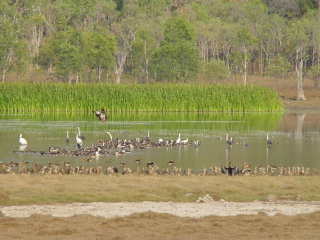
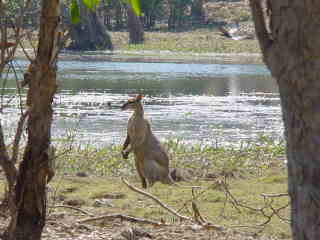
|
We decided to drive ourselves, and managed to get away earlier one afternoon than we had planned, giving us time to stop at an interesting exhibition on the wetlands and bird life that we would be seeing. This part of Australia is subject to generally torrential monsoon rains from November to March, but is dry for the rest of the year. September is an excellent time to see many of the water birds, as they congregate in the increasingly smaller billabongs as the water dries up. We spent the night in a simple hotel near the Mary River with little chalets in the spacious grounds, and run by a nice couple who suggested a good bird watching billabong nearby and who also run bird-watching river trips. So instead of carrying straight on for Kakadu, as we had planned, we got up at first light and went to the billabong, which was delightful at that time of day and which we had to ourselves. There were many magpie geese, whose habitat is becoming endangered across Australia, lots of darters (a sort of shag) holding their wings out to dry and we saw a sea eagle and its nest. We also had our first sight of a wallaby
and of a paperbark tree .

|
We got back to Mary River Park in time for some more breakfast and to join the first river trip, on which we saw wonderful kingfishers, rainbow bee-eaters, a huge glossy, dark heron – the great billed heron, and our first crocodiles, which were up on the banks and incredibly hard to see, to begin with. One could see from the trunks of the trees on the river bank and the sticks still stuck just under the bridge that in the Wet, the river floods some 15 to 20 feet above its September level.
|
|
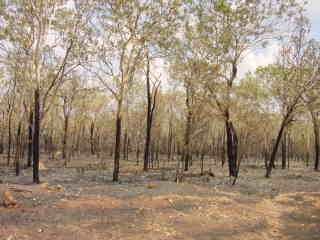
|
We left to drive on the Kakadu, and saw the results of the traditional land management by fire that is practised here. After the wet, the grass grows long and lush, and the aborigines developed a system of setting fire to it before it gets too dry, to prevent uncontrollable wild fires later in the season. This management system has been adopted by the national park rangers. But the grass grows in amongst light woodland of eucalyptus and various types of paperbark trees, so one passes miles of charred looking trunks, though the trees still grow healthily.
|
|
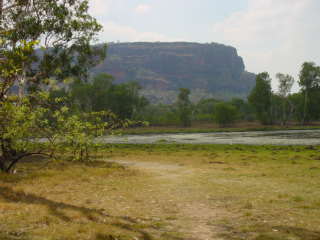
|
Our first stop was Nourlangie Rock, which is an outlying rock of the huge Arnhem Land escarpment. The view from the top was magnificent, but hazy, due to the fires in the distance. Nourlangie is home to some famous aboriginal rock art, which we found hard to capture successfully on film. We were fascinated to discover how relatively little seems to be understood of at least this part of aboriginal culture. The rock art dates back many thousands of years, but can also be over painted (only by certain members of certain tribes), so it is not always clear just what you are seeing. The art is never “touched up” – a different painting or different version of the same subject will be painted over the first, often not obliterating the first, sometimes making it quite confusing.
|
There is a delightful billabong at the base of Nourlangie Rock, which gives good views of the rock itself
as well as of many more birds, such as the ibis and the spoonbill. You can see from the photo of Helen that there were so many flies that we bought wonderful beekeeper-type nets, to keep them from our faces.
|
|
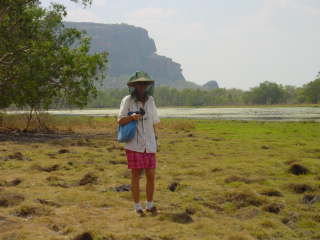
|
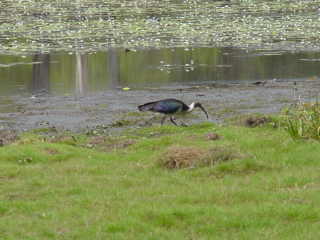
|
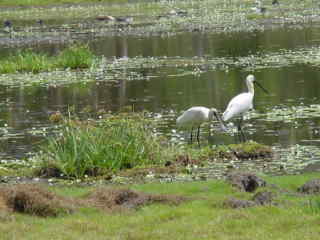
|
|
We spent the night in a large hotel in the centre of Kakadu, where we had our first bath since leaving the Barders in Vilamoura – not quite a year!
|
|
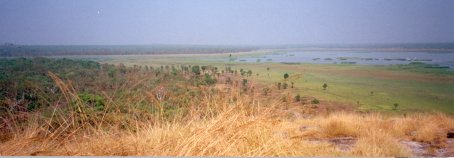
|
|
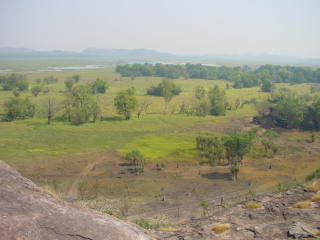
|
The following morning we went to the other main (accessible) rock art site in Kakadu at Ubirr. Here both the art and the landscape were breathtaking.
From the top of Ubirr rock one can see miles of wetlands stretching out over Arnhem Land and also west from Ubirr. The sheer size of the landscape is wonderful. And it is still amazingly green even in September, with a wonderful contrast between the dry ground, the green of the trees and the intense green immediately around the billabongs and rivers.
|
|

|
|
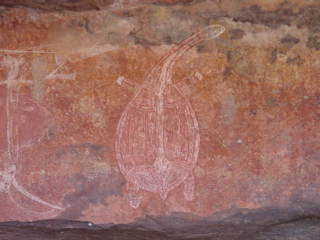
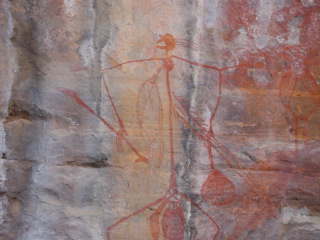
|
And the rock art was captivating – a long necked turtle, a mimi (which populates the aboriginal spirit world) hunting, and several handprints, the second made by spraying paint around the hand from a tube held in the mouth. We particularly took to the representations of the mimis.
|
|
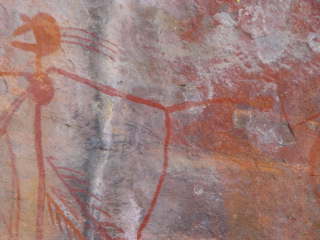
|
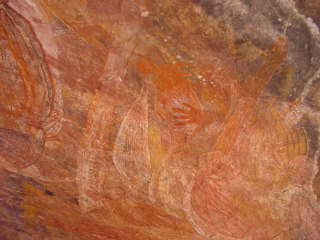
|
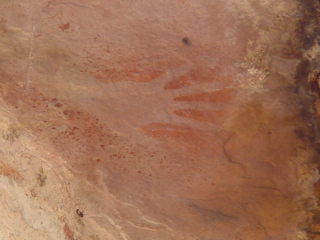
|
|
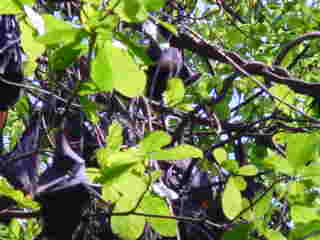
|
The East Alligator River runs close by Ubirr, and we followed a short rainforest walk (monsoonal rainforest) during which we encountered an area of a number of trees absolutely packed with fruitbats, also known as flying foxes, all hanging upside down, flapping their wings now and again, and chattering at great volume.
|
We visited an aboriginal cultural museum, explaining the nomadic life, and how the aboriginals exploited different areas for their different types of food and shelter. The rocks of Ubirr and Nourlangie provided shelter from the Wet, as well as the backdrop for many of the traditional stories and legends.
|
|

|
The following morning was for us the highlight of this trip, with a boat trip on the Yellow Water Billabong, starting at 0645, when it was still misty but beautiful. We were pleased that we had already been looking at birds and also seen some crocodiles, as it meant our eyes were more or less “in” for this trip.
|
 |
We quite quickly saw a crocodile on the bank, just out of the water, and as the boat drew in for a closer look, it growled! We assumed it didn’t like the boat, but the guide backed off, and then another crocodile appeared from behind us, and it was clear that the first was warning off the second. The guide said he had never heard a crocodile growl before! (One always wonders if they find something on each trip that has never happened before, to make the visitors feel good!).
|
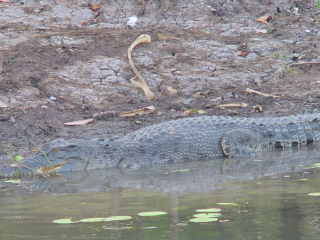
|
|
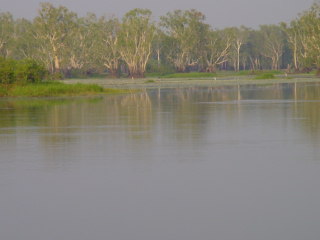
|
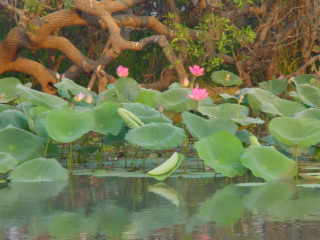
|
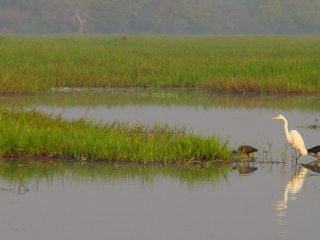
|
The wetlands here are quite beautiful,
surrounded by weeping paperbark trees, and full of water lilies, just coming out as the sun came up. There were birds everywhere, though not always easy to photograph! Various heron – a pied heron, night heron, this white heron, darters again, three kinds of kingfisher(!) – azure, sacred and forest, several white breasted sea eagles, charming little green pygmy geese, small brown plumed whistling ducks, the long-legged jacana bird which lives and runs about on water lily leaves, Australian white pelicans and both glossy (black) and white ibis. And often they allowed the boat to come very close to them, frequently coasting along with its engine off, so that one could really see the birds well.
|
|

|

|
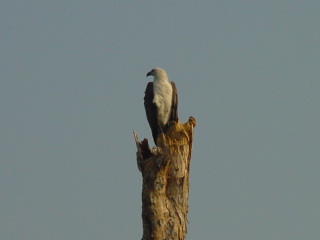
|
|
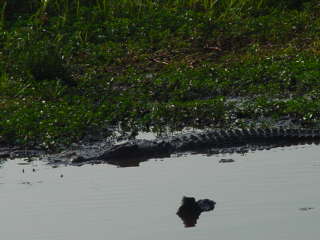
|
We saw several more crocodiles,
though no more dramatic incidents!
|
|

|
Finally it was time to make our way back to Darwin, though we stopped to admire these vast termite mounds.
|
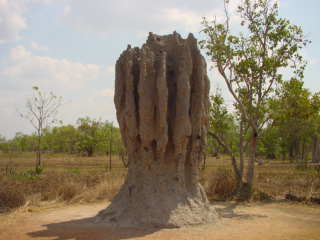
|
Then it was back to final preparations to move on. When we left England, we had hoped to be able to sail to Sri Lanka via Christmas Island and Cocos Keeling, avoiding the notoriously windless route through Indonesia and Malaysia. However, it had become clear that the timing would not work, unless we were prepared to spend even less time in the Pacific than we already had. So our plan now was to head for Bali in Indonesia, stopping en route for Ashmore Reef, another, this time uninhabited, Australian national park.
|
Ashmore Reef |
|
We had been warned to expect light winds, if any, so were lucky to be able to sail, albeit slowly, after the first 30 hours or so. We passed a couple of oil rigs en route, and a few Indonesian lateen rigged sailing fishing boats. Ashmore Reef is about 13 miles across (all largely submerged) with 3 small islands inside the reef. Coral heads abound inside the reef and great care is needed. When we arrived, there were no other yachts, but an Australian Customs vessel and a couple of Indonesian motor fishing boats (this at the time of a political storm over boat people trying to enter Australia illegally). We talked to the Customs vessel on the radio just as they sent a couple of crew in a powerful RIB out to greet us, and they pointed the way to a buoyed channel through the coral to the favoured anchorage on the reef.
|
|
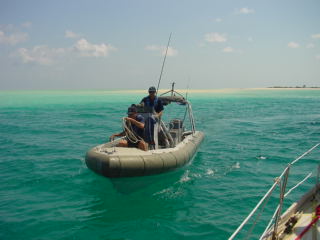
|
Once there, we still felt rather exposed, with West island a long way off and waves pounding on the reef, but as the tide fell, sand spits and reef emerged and the protection improved. For the first time since the Tuamotus, we were the only yacht in the anchorage! Customs proved very friendly and came over later
(with home made muffins for tea!) to talk to us about what they were up to, to point out some of the natural sights and tell us where we were and were not allowed to go. Normally one would require an escort to land on the island, but one of the senior officers, Steve, (an Englishman by birth) decided to trust us to walk only along the appointed part of the beach.
|
Turtles come here to lay their eggs, there are many large rays, and hundreds of sea snakes. These are some of the most venomous snakes around, but fortunately they have very small mouths and are apparently unable to deliver the venom effectively to humans, so we were told it was quite safe to swim.
|
We duly went ashore, from where the colours reminded us of Los Roques in the Caribbean, though the space by contrast seemed unending.
The Customs vessel was several miles across the reef from us, yet is just visible to the left of this photo.
|
|

|
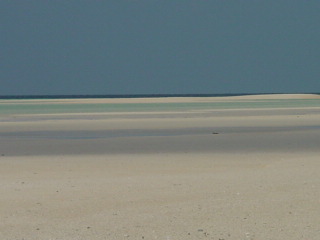
|
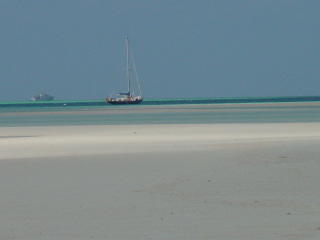
|
Out in the dinghy, we noticed what appeared to be some rocks moving and realised they were a group of turtles, which took flight when we went over to investigate. We subsequently spent quite a lot of time in the dinghy watching them. They were often hard to distinguish from rocks until they started to move. When moving slowly, one could just make out a slight movement of their front flippers, but once they decide to move, their acceleration is amazing, and you can see the front flippers moving very fast and powerfully from some way off. They use the back flippers to steer with. We gradually got better at distinguishing the reddish-brown shade of the shells from the rocks.
We also saw a huge black ray flitting across the shallow water, clearly visible from a long way off - apparently doing a sort of breast stroke with its wings – looking very much as if it was wearing a large black gown, and rather sinister.
While swimming we saw a number of rays – the outline of a black one partly buried in sand which must have been more than 6 feet across, and, tucked under a piece of coral, a much smaller olive green one with pale bright blue tail and spots on its wings.
The water was clear, though without the amazing clarity we had been lucky to find in Suwarrow, and there were many interesting fish, though here of much greater range in size – from tiny brightly coloured fish to large meaty looking ones (no doubt because of the national park’s fishing ban!) We saw a few striped sea snakes reassuringly well below us. Close to the anchor was a small sunken wooden sailing boat, presumably Indonesian (the nearest Indonesian island is about 90 miles north of Ashmore Reef).
|
|
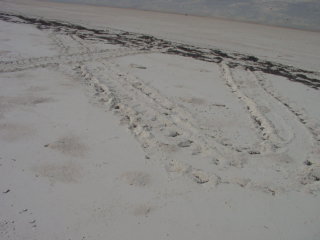
|
Ashore, we soon saw turtle tracks in the sand leading up beyond the high water mark to untidy piles of sand containing the nests. We later heard the pilot of one of the Coastwatch planes saying that on a nearby island a number of turtles had been found killed and stripped of their unlaid eggs.
|
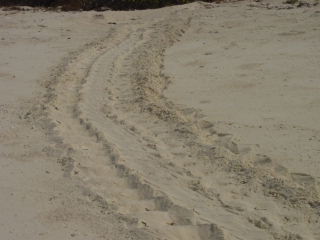
|
|
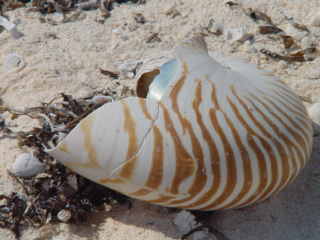
|
There were also amazing numbers of wonderful nautilus shells (under national park rules one may remove nothing!).
|
On our last afternoon, we braved a number of small translucent rust-coloured jellyfish to go for a last swim. This time there were a number of striped sea snakes – some about 3 foot long and about 2 inches wide, with wider flat tails – which were burrowing into the coral on the bottom. Then one of the smaller ones decided to investigate John’s flipper and also swam between his legs, though fortunately didn’t try to wrap itself round them. As we followed a coral garden out of shallow water into deeper water, a small turtle (about 4 foot across) appeared in front of us, which didn’t seem aware (or at any rate frightened) of us, so we were able to swim along behind it for a while, watching exactly how it swam, until it suddenly decided to accelerate away. It was interesting that this one looked much more rock coloured – a grey-brown, very mottled and like a very aged stone, maybe the effect of us being under water with it.
From the dinghy we saw a few turtles put their heads up as they swam, and when they spotted us they really accelerated fast to move away. They seemed to be more alarmed on seeing us when their heads were out of the water, than when they noticed us when they hadn’t surfaced. One gave us a wonderful display, swimming on the surface with his front flippers splashing away. From the boat we saw one (?) swimming along on the surface, with a front flipper idly plopping in and out now and again, with a head appearing now and again, but in the wrong place – at the wrong end, so to speak. It might have been two turtles, but it was impossible to tell!
|
|
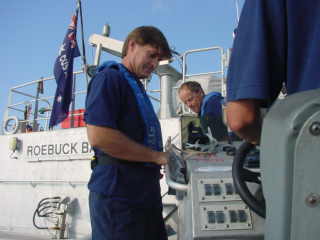
|
The Customs vessel in the outside anchorage was most hospitable. Each afternoon a few crew would come across to the inner anchorage for a swim or a run on the beach, and we would ask them to stop by for a drink or a cup of tea. They offered us fresh water from their water maker and a hot shower on board.
The picture shows their skipper, Brad, and in the background Steve. While we were there, we were shown round the Roebuck Bay, which was very interesting, and had tea with homemade cake! Then we were invited to an excellent dinner too! The ride back to Flame across the lagoon in their RIB by moonlight was beautiful – the full moon was so bright that in the shallow parts you could even see right down to the coral on the sea bed.
|
It was a wonderful place and fascinating to see the turtles so close to, both in and out of the water. And to have it effectively to ourselves, but with generous “hosts”, was a real treat.
|
|
John & Helen
Fleming
Flame of Gosport
17th December 2001
|
|
 |
Return to Home Page |
 |
Next
bulletin - 19th February 2002 |
 |
Previous bulletin -
17th November 2001 |
 |
Ship's Log
Index |